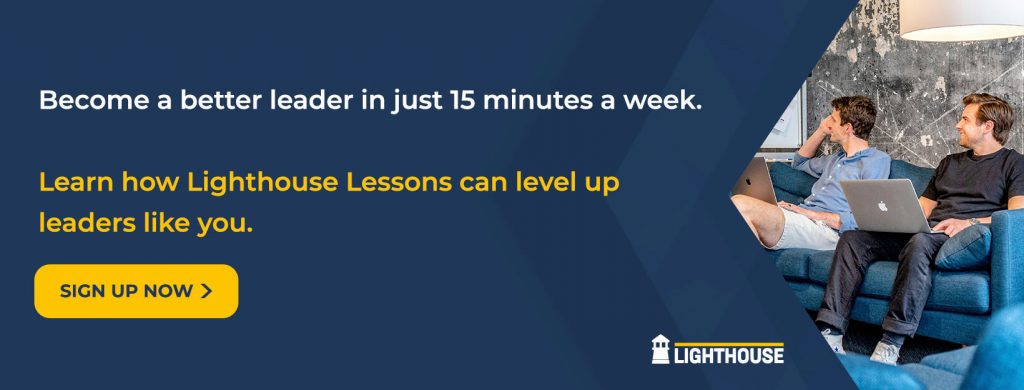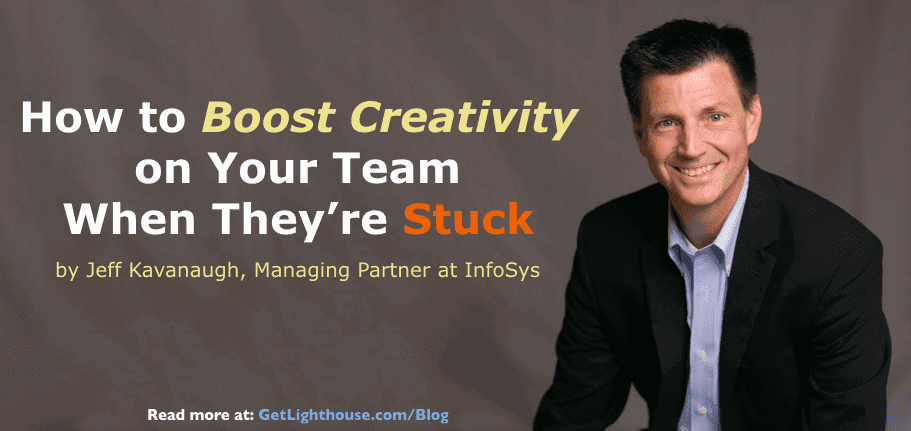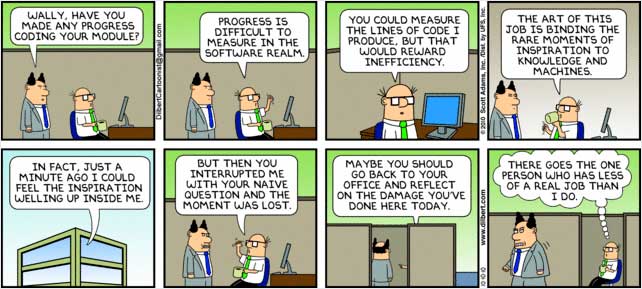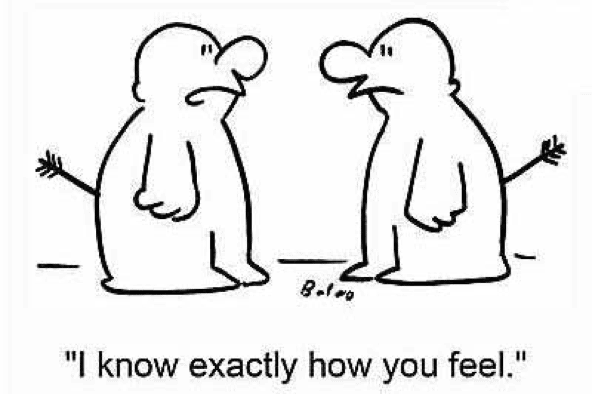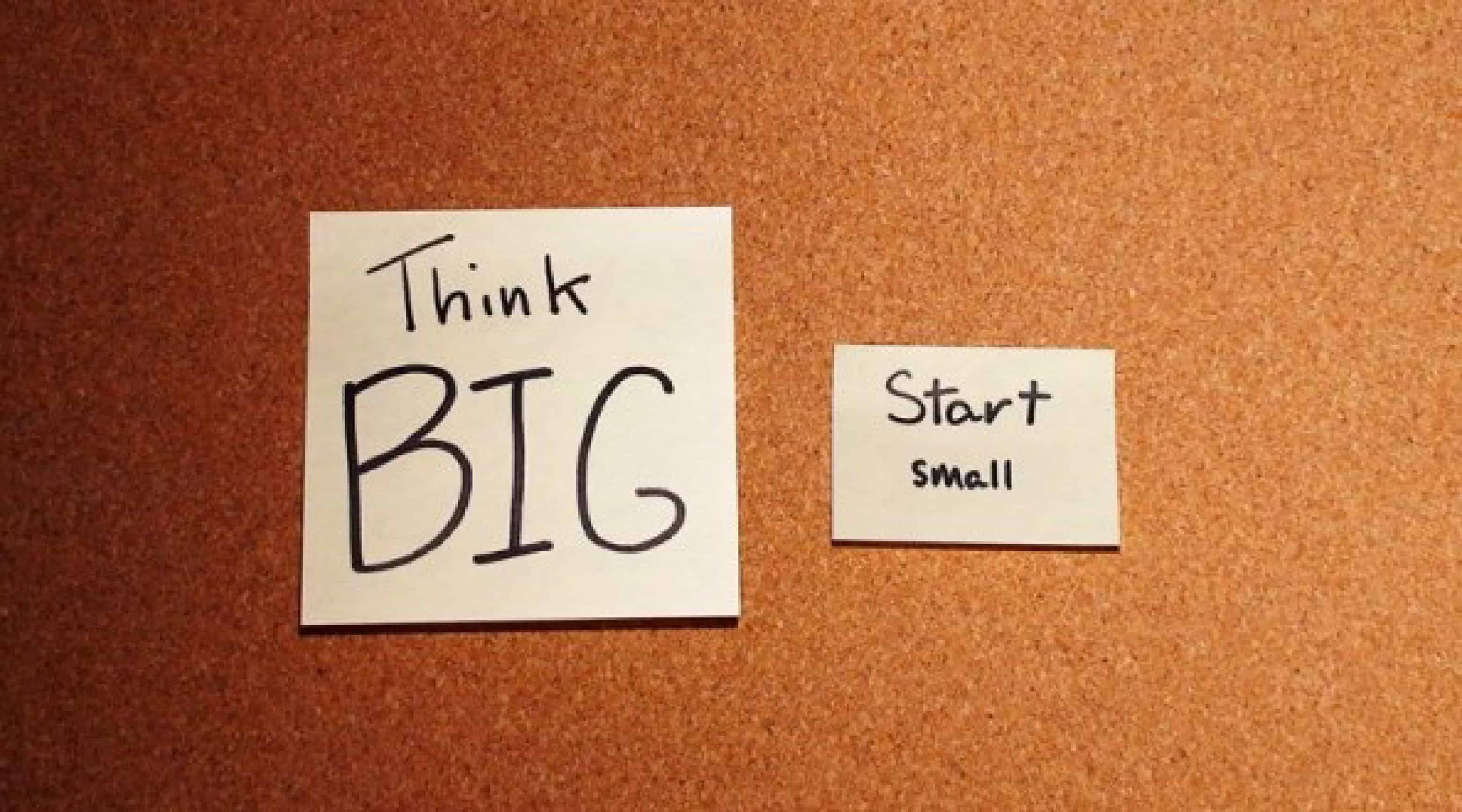JeffKavanaugh.net."I'm stuck. I'm out of ideas."
"We need something better, but I don't know what."
"Let's just go with [mediocre idea]."
If you've ever struggled with coming up with a great solution, you know this feeling. You and your team have tried to think of something awesome, but you're stumped.
It's all in the approach.
[Ed note: This is a guest post from Jeff Kavanaugh, Managing Partner at InfoSys, one of the world's largest consulting firms with over $9bn a year in revenue. He's worked with hundreds of teams to create great solutions.]
What do you do when your team hits a creative roadblock? What do you do when your team simply can't come up with a great solution to a problem you're facing?
A lot of young leaders have the impression that creativity is a given; they believe it can just happen by magic. If you think long and hard enough, or throw enough ideas out, you'll get there. This belief makes creative roadblocks feel impassable, because they lack the tactics and approaches to become unstuck.
However, the reality is, creativity can be manufactured if you follow an effective process.
In my years as a consultant, I've come up with the following four step process to get any team out of this creative jam, boost creativity, and get back into problem solving mode.
A battle-tested process to boost creativity on your team
1. Give Your Team's Imaginations Space To Work
Context switching kills creativity. I don't mean that hyperbolically—your brain is actually incapable of switching seamlessly between tasks.
In a 2006 study, Dr. Nick Yeung from the University of Oxford detailed something he called "task set inertia.” According to his findings, the areas of the brain that fire for one task will continue firing even when you switch to another task.
To put it into a work context, if you take 15 minutes to answer email, the areas of your brain responsible for handling communication will continue to fire even if you switch to something else.
As a leader, this mean you must remove yourself—and most other stressors—from your team's environment when you want them to be creative and focus.
Buzzing them with emails, asking them to context switch to another project, or even popping in to check on their progress too often can divide their attention and lessen their creativity.
However, giving them uninterrupted time is not enough by itself. Giving them their space also means giving them time to rest.
Encourage your team not to try and fit a little work in after dinner. As Cal Newport wrote in Deep Work:
"Even if these work dashes consume only a small amount of time, they prevent you from reaching the levels of deeper relaxation in which attention restoration can occur.”
By giving your team uninterrupted time to focus on their creative task at hand, and enough time for true relaxation and restoration, you're laying the foundation for sustained creativity.
2. Use Empathy To Truly Understand Your Problem
Often, your first instinct when you feel the stress of a roadblock is to turn on your brain power and try to break down the problem.
However, a 2015 study at Kongju National University found that when we're under personal distress, our critical thinking skills decrease. Instead, if you engage the problem with empathy, your critical thinking abilities can soar.
So how do you do that?
The key is to understand the problem from your end user's view. To get in their shoes, Stanford's Design School teaches students a process called, "empathetic problem solving” that includes the following steps:
- Observe: Learn how people are currently solving the problem your project is trying to address. They may have a solution, or half of one, you never considered.
- Engage: Ask your stakeholders loose, open-ended questions to understand how your project will benefit them. This will reveal deeper nuances of the problem you are solving.
- Unpack: Get everyone on the team to share what they learned in a visual way. Photos, charts, drawings—whatever it takes to get the insights out of their heads. Everyone on your team will see things a little differently.
By understanding the problem through the lens of those affected by it (usually either customers or fellow employees), your team can fully grasp the problem they are solving, and approach from new angles. This opens up all kinds of ideas, opportunities, and solutions that they may have never considered otherwise.
The best ideas, and sparks of inspiration for your team, often come from those who are experiencing the problem first hand. Make sure you are using empathy to understand your end user when you want to boost creativity on your team.
3. Get Agile and Test Solutions Rapidly
When your team hits a roadblock, there will inevitably be a lot of spit-balling. It's easy to generate a ton of ideas, but you can't test them all.
You can take an idea that is fundamentally flawed and spend days trying to make it work. Especially young professionals can tend to spin their wheels on bad ideas.
Software developers of all ages also regularly face this same problem. Historically, the traditional software model involves creating a complete project, then testing it, then rebuilding the entire project, then testing it again, and on and on in an exhausting, inefficient cycle.
Agile is here to help.
Back in 2001, agile development came about as a solution to this problem for software teams.
In agile, projects are built and tested iteratively. A piece of software will be built with basic functionality, and tested. Then one feature will be added and tested. Then another, and another. Each step is smaller, allowing you to move faster, and ensure you're moving in the right direction each time.
Agile is incredibly useful for all businesses, not just developers, as it saves money, time, and frustration.
When a team member throws out an interesting idea, take it 10% of the way. If the first iteration of the solution has significant issues, you'll know it's not worth pouring more time into.
If your team builds and tests their solutions incrementally, your project can adapt rapidly, and bad ideas can be abandoned quickly. You'll boost creativity by making it safe to test any idea that looks promising, all with little risk.
4. Overcome the Fear of Failure in Your Team Members
Creative work is a vulnerable thing. You're creating something out of nothing more than your own brain power and insight. This makes it easy to take failure hard.
Your team members may hesitate to pursue ideas they have because they, "aren't the creative types,” or they are afraid an idea they have isn't 100% sure to work. This fear is a major blocker if you want to boost creativity for everyone on your team.
Defeat fear with creative confidence.
The solution to this is something called "creative confidence,” a term coined by Stanford professor David Kelly.
The idea is simple. When people overcome phobias, they tend to perform better in all areas of their life, even ones seemingly disconnected from their phobia.
If you treat your team members' hesitancy to put forth ideas like a phobia, you can improve their performance across the board. As a leader, this means slowly pushing your team members.
First, come to them and help craft and present their ideas. By sharing responsibility, you'll ease their personal anxiety about the success of the idea. If it doesn't work, it's on both of you, not just them.
Then, slowly push them to be more independent. If you've been making the ideas agile, they'll see how low-risk testing an idea really is, and how short term a memory everyone has. Eventually, they'll be testing ideas completely on their own, because they'll have the creative confidence to take failure in stride.
--
With a few tweaks to the approaches you and your team use, you can boost creativity every time you need to solve a problem. Make these tips from Jeff Kavanaugh a part of your process and make mental roadblocks a thing of the past.
Further Reading: Want to learn more about how to boost creativity? These are great places to start:
- Watch this amazing talk on creativity by legendary actor and comic, John Cleese.
- Learn how Ed Catmull, President of Pixar, has built such an amazing company with takeaways from Creativity, Inc.
- Find out how Steve Jobs used "Cauldrons" to come up with the best ideas at Apple.
About the guest author: 
Jeff Kavanaugh is a Managing Partner at InfoSys, one of the world's largest consulting firms with over $9bn a year in revenue and a market cap in the 11-figures. He also serves as an Adjunct Professor at the University of Texas at Dallas and writes at JeffKavanaugh.net.
